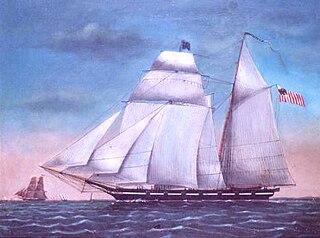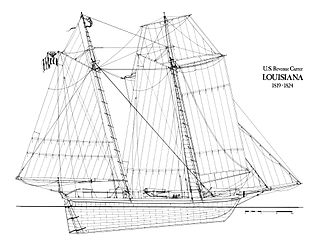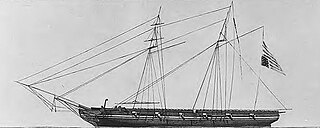
The United States Revenue Cutter Service was established by an act of Congress on 4 August 1790 as the Revenue-Marine upon the recommendation of Secretary of the Treasury Alexander Hamilton to serve as an armed customs enforcement service. As time passed, the service gradually gained missions either voluntarily or by legislation, including those of a military nature. It was generally referred to as the Revenue-Marine until 31 July 1894, when it was officially renamed the Revenue Cutter Service. The Revenue Cutter Service operated under the authority of the U.S. Department of the Treasury. On 28 January 1915, the service was merged by an act of Congress with the United States Life-Saving Service to form the United States Coast Guard.
The first USS Eagle, a schooner, was built at Philadelphia, Pennsylvania, in 1798, and commissioned in the Revenue Cutter Service under the command of Captain H. G. Campbell, USRCS. She placed under control of the Navy in July 1798 for service in the undeclared naval war (Quasi-War) with France.
Vigilant was one of the original ten cutters employed by the Federal government of the United States which made up the Revenue Marine, or Revenue Cutter Service, later to become the United States Coast Guard.

Harriet Lane was a revenue cutter of the United States Revenue Cutter Service and, on the outbreak of the American Civil War, a ship of the United States Navy and later Confederate States Navy. The craft was named after the niece of senator and later United States President, James Buchanan; during his presidency, she acted as First Lady. The cutter was christened and entered the water for the Revenue Service in 1859 out of New York City, and saw action during the Civil War at Fort Sumter, New Orleans, Galveston, Texas, and Virginia Point. The Confederates captured her in 1863, whereupon she was converted to mercantile service. Union forces recaptured her at the end of war. The U.S. Navy declared her unfit for service and sold her. New owners out of Philadelphia renamed her Elliot Ritchie. Her crew abandoned her at sea in 1881.
USS Gallatin was a post-Revolutionary War sailing vessel that the U.S. Department of the Treasury purchased at Norfolk, Virginia, for the United States Revenue-Marine in December 1807. An explosion on board destroyed her in 1813.

The United States Revenue Cutter Hamilton was one of 13 cutters of the Morris-Taney Class to be launched. Named after Secretaries of the Treasury and Presidents of the United States, these cutters were the backbone of the Service for more than a decade. Samuel Humphreys designed these cutters for roles as diverse as fighting pirates, privateers, combating smugglers and operating with naval forces. He designed the vessels on a naval schooner concept. They had Baltimore Clipper lines. The vessels built by Webb and Allen, designed by Isaac Webb, resembled Humphreys' but had one less port.
USRC Walter Forward was a schooner constructed for service with the United States Revenue-Marine. She was more commonly known as USRC Forward. Forward served with the United States Army and United States Navy in Mexican waters during the Mexican–American War and was commended for her actions during the Tabasco River landings by Commodore Matthew C. Perry, U.S. Navy. After the war, she was transferred to the United States Coast Survey for a short time as USCS Walter Forward before being returned to the Revenue-Marine for service during the 1850s and the American Civil War.

USRC Seminole was a 188 ft (57 m), 845-ton United States Revenue Cutter Service steamer constructed by the Columbian Iron Works in Baltimore, Maryland for $141,000. She was commissioned in 1900 and saw service through 1934, when she was transferred to the Federal Emergency Relief Administration.
One of the first ten revenue cutters, Active may have been the second of the ten cutters to enter service. The Columbian Centinel on 30 April 1791 noted:
A Revenue Cutter, was launched at Baltimore the 9th inst. at Captain Stodder's Ship Yard, and is considered by good judges, a beautiful vessel. She is to be commanded, we hear, by Capt. Gross, formerly First-Lieutenant of the Continental Frigate CONFEDERACY.

USRC Massachusetts was one of the first ten cutters operated by the Revenue-Marine. She was built in Newburyport, Massachusetts, and served out of Boston. Massachusetts by tradition is held to be the first revenue cutter to enter active service. She was also the first to be decommissioned, having a very short service life of only about 15 months before being sold.
USRC Diligence was one of the first ten cutters operated by the United States' Revenue Cutter Service.

USRC Eagle was one of the first ten cutters operated by the United States Revenue-Marine, which later became the United States Revenue Cutter Service and later still became part of the United States Coast Guard.

The Thomas Corwin was a revenue cutter of the United States Revenue-Marine and United States Revenue Cutter Service and subsequently a merchant vessel. These two very different roles both centered on Alaska and the Bering Sea. In 1912, Frank Willard Kimball wrote: "The Corwin has probably had a more varied and interesting career than any other vessel which plies the Alaskan waters."
USRC Forward was a revenue cutter constructed for the U.S. Revenue Cutter Service in 1882 by Pusey & Jones shipyard in Wilmington, Delaware. She was the second Revenue Cutter Service vessel named Forward and was named for Walter Forward, the fifteenth United States Secretary of the Treasury. The iron-hulled vessel originally cost US$72,750 and was powered by a two-cylinder steam engine with a topsail schooner brigantine sail pattern. Although Forward was considered a model ship at the time of its construction, it was severely underpowered and had unreliable machinery. The cost of repairs in the first fifteen years of operation was US$52,000.
The capture of the schooner Bravo was a naval battle fought in 1819 between United States Revenue Cutter Service cutters and one of Jean Lafitte's pirate ships.

USRC Louisiana, was a wood hull topsail schooner designed by William Doughty that was commissioned in the United States Revenue Marine from 1819 to 1824. Assigned the homeport of New Orleans, Louisiana, she sailed the Caribbean extensively and was used mainly in anti-piracy activity.

The West Indies Anti-Piracy Operations were a series of military operations and engagements undertaken by the United States Navy against pirates in and around the Antilles. Between 1814 and 1825, the American West Indies Squadron hunted pirates on both sea and land, primarily around Cuba and Puerto Rico. After the capture of Roberto Cofresi in 1825, acts of piracy became rare, and the operation was considered a success, although limited occurrences went on until slightly after the start of the 20th century.
The USRC James Madison was a schooner named for Founding Father James Madison and launched in 1807 at Baltimore for service with the United States Revenue-Marine. During the first months of the War of 1812 she captured several merchant vessels, but in August 1812 HMS Barbadoes captured her. Lord Belmore, of Enniskillen, bought her and converted her to a privateer brig named Osprey. After the end of the Napoleonic Wars and the War of 1812 she became a yacht for a family trip to the eastern Mediterranean. In 1819, at the end of the trip, Bellmore sold her to Ferdinand I, King of Naples; her ultimate fate is unknown.

USRCSurveyor was a ship of the United States Revenue Marine captured by the United Kingdom during the War of 1812. Despite the vessel's loss, the "gallant and desperate" defense of her crew against a superior force of the Royal Navy and the Corps of Royal Marines is commemorated by the United States Coast Guard. Along with the Royal Navy frigate which bested her in battle, HMS Narcissus, Surveyor is among six legendary ships memorialized in the lyrics of the Coast Guard march "Semper Paratus".

HMS Narcissus was the lead ship of the Royal Navy Narcissus-class 32-gun fifth-rate frigates, launched in 1801. She participated in the War of 1812.










